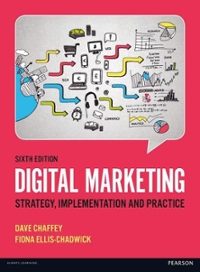Spotify is a streaming music service originally developed in 2006 in Sweden and launching in 2008. Spotify
Question:
Spotify is a streaming music service originally developed in 2006 in Sweden and launching in 2008. Spotify Ltd now operates as the parent company in London while Spotify AB manages research and development in Stockholm. This case study about the online music subscription service illustrates how different elements of the mix can be varied online. It also highlights success factors for developing an online marketing strategy.
In early 2015, Spotify was valued at more than $5 billion. Investments in the growth of the company have been $1–2 billion in seven rounds of funding from 17 investors.
Spotify was not the first online entrant to online music services, but it was an innovator in marketing approaches, technology and subscription options that have enabled it to become a market leader in music subscription. The first major entrant was in 1999 through Napster which we have featured in previous editions of this text in this chapter. Its initial incarnation was as the first widely used service for ‘free’ peer-to-peer (P2P) music sharing. The record companies mounted a legal challenge to Napster due to lost revenues on music sales which eventually forced it to close. But the Napster brand was purchased and its second incarnation still offers a legal music service, although following bankruptcy in 2008 it has had several owners such as Roxio and Best Buy. Napster now focus on the music subscription service as part of the Rhapsody music services in direct competition to Spotify.
Spotify operates a freemium model, with the majority of its users streaming music to their mobiles or desktop via apps or web browsers. Users who subscribe for free get ads between tracks, which are part of the Spotify revenue model. Users of the free service encounter audio ads every five or six songs, or approximately three minutes of advertising for every hour of listening.
Since many users enjoyed the unlimited free music option, Spotify moved to limit this in April 2011, when it announced that audio streaming would be limited to ten hours per month after an initial unlimited listening period of six months. This restriction was removed in 2014. Spotify Premium users who pay a fixed monthly fee get additional features including offline listening and no ads. The Wikipedia entry for Spotify has charted the growth of Spotify:
In November 2011 more than 2.5 million paying subscribers signed up to its service. This followed 500,000 premium users signing up since its partnership with Facebook’s ‘Open Graph’, which allows people to share the tracks they were listening to with friends. It also launched in the United States in 2011.
In August 2012 there were four million paying Spotify subscribers responsible for at least €20 million per month in revenue.
By March 2013, Spotify had grown to six million paying customers globally (a figure that remained in December 2013) and 24 million total active users.
By May 2014, Spotify had grown to ten million paying customers and 30 million free users.
By January 2015, Spotify had grown to 15 million paying customers and 45 million free users.
Question
Assess how Spotify competes with traditional and online music providers by reviewing the approaches it uses for different elements of the marketing mix.
Step by Step Answer:





